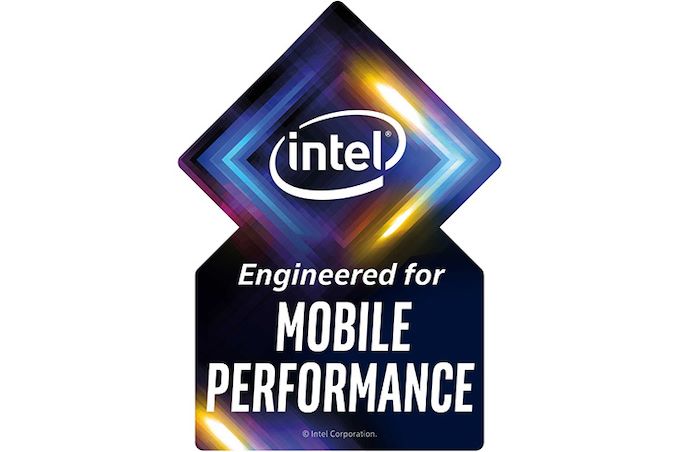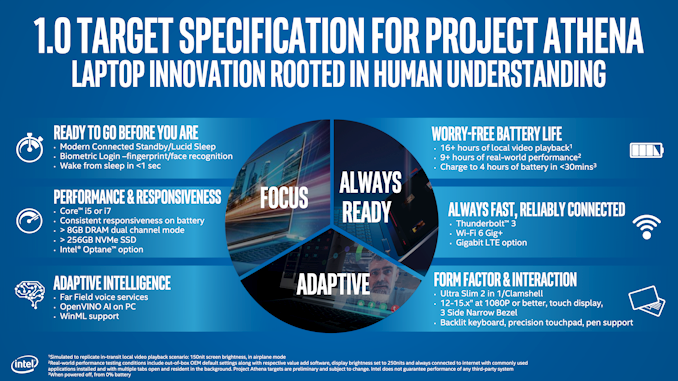Intel Unveils ‘Engineered for Mobile Performance’ Badge for Project Athena Program
by Anton Shilov on August 12, 2019 12:00 PM EST- Posted in
- Notebooks
- Intel
- Laptops
- Ice Lake
- Project Athena
- 10th Gen Core

With the release of the first Ice Lake-U laptops, Intel has announced that there will be a badge/visual identifier for laptops that comply with Intel's Project Athena standard. The ‘Engineered for Mobile Performance’ label will be used for online listings, product pages, on in-store display systems, on packaging, and for demonstrations. Do note, however, that there won't be any ‘Engineered for Mobile Performance’ badges on actual notebooks. Apparently, neither Intel nor PC makers want to put badges on the chassis of premium computers (this itself typically being treated as a premium feature).
Stylized like a medal, Intel’s ‘Engineered for Mobile Performance’ label indicates that a particular notebook meets Intel’s key experience indicators (KEI) for Athena laptops, which stipulate requirements for performance, features, and battery life, among other things. As previously announced, Intel is doing Athena verification itself, so any product carrying the label means that it has been verified by Intel’s tests and conducted by Intel’s specialists.
With the Athena specifications set to be revised every year, for this first year’s ‘Engineered for Mobile Performance’ notebooks that comply with the Project Athena v1.0 specification, Intel wants the following.
| Intel Project Athena v. 1.0 Requirements | ||
| Feature | Requirement | |
| Form-Factor | An ultra-thin clamshell or convertible notebook, or a 2-in-1 hybrid PC. | |
| Display | Touch-enabled 12 – 15-inch display with narrow bezels. At least a Full-HD resolution. Stylus support |
|
| Internal Hardware | Intel’s 10th Gen Core i5 or Core i7 processor with Intel Dynamic Tuning Technology. At least 8 GB of dual-channel DRAM. At least a 256 GB NVMe SSD with or without Optane H10 caching SSD. |
|
| Responsiveness | Consistent responsiveness both on battery and on power outlet. | |
| Instant Action | Connected Standby/Lucid Sleep support. Wake up from sleep in less than a second. Wake up to Internet browsing time should not exceed two seconds. |
|
| Wireless Connectivity | Wi-Fi 6 and optional Gigabit LTE. | |
| Wired Connectivity | Thunderbolt 3. | |
| Battery Life | At least 9 hours of mixed-workload battery life at 250 nits display brightness. At least 16 hours of local video playback. Fast charge support. |
|
| Intelligence | Far Field microphone with voice services. Hardware-accelerated OpenVINO AI and WinML support (which requires Ice Lake). |
|
| Interaction | Backlit keyboard, precision touchpad, touch display, stylus. | |
While the PC notebook market is (and will remain) widely varied in features, performance, and prices, Intel is ultimately aiming to tighten up the high-end portion of the market by giving its OEM/ODM partners goals, and matching incentives to reach them. PC hardware in general has been a continual race to the bottom – OEMs are always looking for an edge in costs/price – so in this respect Athena is an effort to entice OEMs to use higher-quality, more expensive (and frequently all-Intel) parts for better performance and greater energy efficiency. Intel is no stranger to this strategy, having employed something similar for both their Centrino and Ultrabook programs, so they are once again turning to it to shape the direction of high-end laptops going into 2020, as well as fending off a push from Arm-based laptops.
The first laptop to meet Intel’s Project Athena program requirements is Dell’s XPS 13 2-in-1 model 7390 that became available on August 8. Shortly, Acer’s Swift 5, HP’s Envy 13 Wood Series, and Lenovo’s Yoga S940 will also make their debut.
Related Reading:
- Intel's Project Athena: Defining The Next Generation Of Premium Laptops
- Intel Unveils 10th Gen Core Ice Lake-U & Ice Lake-Y Mobile CPUs: 10nm Sunny Cove Later This Year
- Examining Intel's Ice Lake Processors: Taking a Bite of the Sunny Cove Microarchitecture
Source: Intel











49 Comments
View All Comments
silverblue - Tuesday, August 13, 2019 - link
Zen 2's efficiency is boosted by simply not having the X570 chipset due to its PCIe 4.0 support. I'm not sure Intel really offers much more than AMD but I'm happy to be proven wrong.Samus - Wednesday, August 14, 2019 - link
Zen 2 will no doubt be a performance monster in mobile, but in the 15w envelope, I doubt it will compete with Intel. AMD has had a lot of trouble scaling it below 25w (which, granted, Coffee Lake and above often operate at during TDP-up.)That all comes down to process efficiency. But with AMD's creative and frankly game-changing chiplet topology they might be able to pull it off.
Good times for consumers.
milkywayer - Monday, August 12, 2019 - link
This is wonderful if the laptops are remotely affordable. But seeing as much manufacturers are charging upwards of $1200 for 8GB / 256GB / 1080p ultra thins, I believe these will be in in $2000+ category.Samus - Wednesday, August 14, 2019 - link
If you are willing to get a previous-gen laptop (Coffee Lake) you can easily get something that was $1000+ at launch for <$500 now. I just picked up a Dell Latitude 5290 for $450 brand new on eBay with an i5-8350U, 8GB DDR4 and 256GB NVMe SSD. Unfortunately the m2 slot is only 2 lanes :(neblogai - Monday, August 12, 2019 - link
If only AMD cared to do the same. Setting something like 'Silver' tier requirement (1080p IPS/VA, dual channel 8GB, SSD) and 'Gold' requirements ('Silver'+ small bezzels, thin/light/2in1; biometrics, lit keyboard, 6h+ battery life, 20W+ STAPM) would make it much easier to recommend an AMD laptop than it is now.HStewart - Monday, August 12, 2019 - link
The problem is AMDFan's will blame it on the vendors and not actually AMD. Does anybody actually own an AMD laptop - they always state get Zen+++ but what they say instead is don't buy Intel because I and other AMD Fan boys don't care for it. That Attitude is primary reason why I will refused to ever purchase. I made that mistake with Dell XPS 15 2in1 but it only the video.Korguz - Monday, August 12, 2019 - link
umm.. yea ok there hstewart. the ONLY reason you wont buy amd, is because you fanatic intel fanboyism, wont allow you to. and FYI it IS the oems that have made the amd notebooks the way they are, not giving them much thought or features compared to the intel based ones... and i own 2 amd based notebooks.. and that is mostly due to price, and because for what i needed.. intels igp.. is crap, where amds igp.. is stronger over all. i wont eveb consider an intel based notebook if it uses intels igp.bji - Monday, August 12, 2019 - link
The first person to use the term 'fan boy' in any discussion is the *actual* fan boy. True fact.Korguz - Tuesday, August 13, 2019 - link
bji, ironic, isnt it ? the biggest fanboy, calling some one else a fanboy.MonkeyPaw - Monday, August 12, 2019 - link
Nonsense. This is as much an advertising initiative than anything. Vendors who comply with this “standard” will get advertising dollars from Intel to run commercials. Anytime you see a Dell or HP add for a PC that ends with Intel noises, you know Intel helped pay for the ad. AMD doesn’t have the money to burn here to get OEMs to “participate” in an initiative.